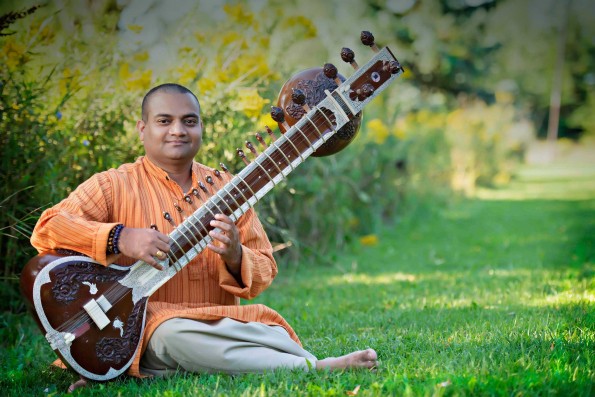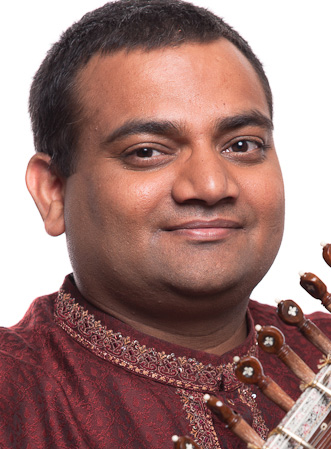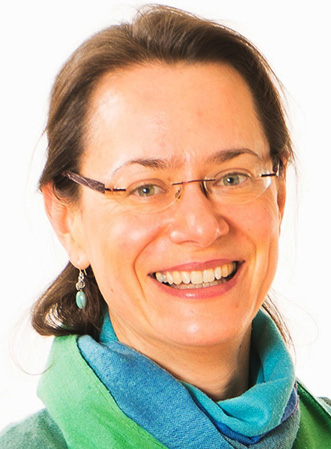Interview with Ram Vakkalanka (EN)

Ram, you like to call yourself a yoga philosopher. That sounds unique and fascinating. What is your background and what exactly do you do?
Ram: Many people think of Yoga as a form of physical exercise. While it is true that Yoga has a strong tradition of physical practices, it is actually a philosophy and a way of life. Yoga is a set of principles and practices that have been designed by ancient Seers of the East to help us be our best. These principles and practices can be applied to all aspects of our life.
If we take these principles and practices and apply them to the body, the result is Yoga postures. We take these principles and practices and apply them to breath, the result is Pranayama. These principles and practices applied to mind is Meditation, applied to speech is Sanskrit, applied to music is Nada Yoga and applied to food is Ayurveda. The principles and practices of Yoga are universally applicable to everyone and transcend cultural, linguistic and other differences. I travel around the world teaching and educating many people about the deep, rich philosophy behind the Yoga postures. I share my knowledge at many Yoga studios, Universities, Yoga festivals and Retreats.
As for my background, I was born and brought up in India, in the Vedic tradition. Yoga has always been part of my life and I studied Yoga philosophy, Sanskrit, Nada Yoga and Tantra since childhood. I also received regular education and qualified as a Chartered Accountant, Management Accountant, Chartered Secretary and Master of Finance. I was part of the higher management in many companies and lived and worked in India, Singapore, Africa and North America. At a certain stage in my life, I realized that my Dharma is to share my knowledge of Yoga philosophy. I left the corporate world to exactly that. Now, I travel around the world sharing my knowledge of Sanskrit, Yoga Philosophy, Tantra and healing people thru Sacred Vibrations in the form of Mantra, Nada Yoga and Meditation.
You grew up in India and now share your knowledge about Sanskrit and the ancient texts with people in the West. How relevant are the ancient texts for us today?
Ram: The ancient texts are more relevant to us today than they have perhaps ever been. If we think about it, we realize that even though times have changed and technology has advanced, human beings haven’t changed that much fundamentally. Technology and innovation just brought in convenience and speed to the things we have always been doing. For example, human have always travelled from place to place. What used to take months in ancient times perhaps takes hours in modern times, thanks to technology, but travelling has always been there in human nature. One more thing to note is that this convenience and speed comes at a great cost…environmental impact. As we haven’t changed fundamentally since ancient times, the principles of ancient texts still continue to be very much relevant us. In fact, we need them more now than ever to counteract the negative side effects of modern life style factors such as stress. Ancient texts teach us the true purpose of life and how to live in perfect harmony with Nature. The principles taught by the Rishis, ancient seers of East, will always be relevant for all people, of all ages to come.

You are considered as an authority on Nada Yoga. You play the Sitar and give concerts as well as use the Sitar in your guided meditations. Many people feel deeply moved by traditional Indian music. Wherein lies the particular power of ragas and nada yoga?
Ram: A Raga is like a medicine that uses musical tones rather than chemicals as healing ingredients. A Raga has a particular psycho-somatic impact on the listeners. Raga heals us by correcting the subtle, inner vibrations. Vibration when combined with Intention results in inner healing. Therein lies the power of Raga to touch, heal and uplift us. Ragas are also linked to particular time of the day and season of the year, when they have their highest impact. Ragas were created by ancient Rishis with an intention to heal people thru music. Performing or listening to a Raga mindfully is also a kind of Yoga, known as Nada Yoga. Nada Yoga is a wonderful combination of the art of music and the science of energy healing. Yoga teaches us that there is more to life than mind, body and senses. Nada Yoga opens a vista into those higher realms of consciousness.
So amongst other things, you are a meditation instructor and give workshops all around the world. Which mediation techniques do you mainly teach?
Ram: I teach many techniques of meditation that fall under different traditions. However, I mainly teach various techniques of Chakra Meditation, Nada Meditation, Vedanta Meditation and Mantra Meditation.
Could you please give us a taste of a brief meditation practice which we could do ourselves at home?
Ram: Absolutely…
Sit straight in any comfortable posture. You could be seated on a chair, if you like. Inhale deeply, filling your lungs with pranic energy from the Universe. Hold the breath in for a couple of seconds and then exhale thoroughly. Scan your body from the crown of the head to the tips of the toes, notice any areas of tightness and relax them.
Gently guide your awareness to the base of the spine. Visualize a red Lotus flower having four petals at the base of the spine. Chant ‘Lam’ three times, either aloud or mentally. Allow yourself to feel grounded and connected to your life and being, while you meditate on the Root Chakra for as long as you would like. Next, guide your attention a little higher to the genital region. Visualize an orange colour Louts flower with six petals. Chant ‘Vam’ three times, either aloud or mentally. Keep your focus on the Chakra for as long as you like and allow yourself to experience a sense of sexual and emotional well-being. Whenever you are ready, gently guide your awareness to the solar plexus region. Visualize a Lotus flower in yellow colour with ten petals. Chant ‘Ram’ three times, either aloud or mentally. Stay with the Chakra for as long as you like and allow yourself to experience a sense of personal power that originates in this Chakra. Taking your time, bring your awareness to the heart region. Visualize a Lotus flower in green colour with twelve petals. Chant ‘Yam’ three times. Stay with the Chakra for as long as you like and connect with the fountainhead of love and compassion rooted in your heart. Whenever you are ready, gently bring your awareness to the throat region. Visualize a Lotus flower in blue colour with sixteen petals here. Chant ‘Ham’ three times. Keep your focus on the Chakra for a few moments and experience your creative energies waking up, ready to find expression. Taking your time, gently bring your awareness to a little above the point between your eye brows. Visualize a Lotus flower in indigo colour with two petals. Chant ‘Om’ three times. Stay with the Chakra for a few moments and connect with your intuition and higher intellect. Whenever you are ready, guide your awareness to the region about four finger-widths above the crown of your head. Visualize a white Lotus flower with infinite petals. Chant ‘Om’ three times. Stay connected with the Chakra for a few moments and experience your energy levels soar up, feel great about yourself, feel a sense of expansion and limitlessness.
Taking your time, connect with your body and breath again. Wiggle your toes, move your fingers slowly. Whenever you feel ready, slowly open your eyes and chant ‘Om’ three times aloud or mentally.
This brief meditation helps balance your Chakras, be in the moment and maintain high levels of energy throughout the day. I recommend using my album ‘Inner Harmony’ in the background if you prefer.
Dear Ram, thank you very much.
Interview by Kaivalya Meike Schönknecht.
 Ram Vakkalanka is a Sanskrit expert, meditation instructor, sitar performer and kirtan singer. He grew up in India, immersed in music and the Vedic tradition. Ram shares his expertise about yoga philosophy and nada yoga through worldwide retreats, talks and concerts. He has released several CDs with guided meditations and healing ragas. Ram Vakkalanka’s website is www.aksharayoga.com and he welcomes people to connect with him via his website or Facebook. Ram Vakkalanka is a Sanskrit expert, meditation instructor, sitar performer and kirtan singer. He grew up in India, immersed in music and the Vedic tradition. Ram shares his expertise about yoga philosophy and nada yoga through worldwide retreats, talks and concerts. He has released several CDs with guided meditations and healing ragas. Ram Vakkalanka’s website is www.aksharayoga.com and he welcomes people to connect with him via his website or Facebook.
——————————- |
 Kaivalya Meike Schönknecht is a Sivananda Yoga Vedanta teacher with various further teacher training qualifications at Yoga Vidya. Kaivalya grew up in Hamburg and lived in England for many years, where following her master degree she worked in publishing for ten years. In 2013 she joined Yoga Vidya Bad Meinberg to dedicate herself more fully to practicing and teaching yoga. Kaivalya Meike Schönknecht is a Sivananda Yoga Vedanta teacher with various further teacher training qualifications at Yoga Vidya. Kaivalya grew up in Hamburg and lived in England for many years, where following her master degree she worked in publishing for ten years. In 2013 she joined Yoga Vidya Bad Meinberg to dedicate herself more fully to practicing and teaching yoga. |
- The German version of this interview was published in Yoga Vidya Journal Issue 31.
- Here you can find the German version: Interview mit dem Yoga Philosophen Ram Vakkalanka
- Seminars at Yoga Vidya
- Yoga Holiday in Europe’s biggest Yoga Resort
- Related Yoga Articles
Immerse yourself in the world of Nada Yoga:
- Theme week: Nada Yoga with Ram Vakkalanka – Power of Sound
Yoga Vidya Bad Meinberg: 6.-12. June 2016

0 Kommentare zu “Interview with Ram Vakkalanka (EN)”